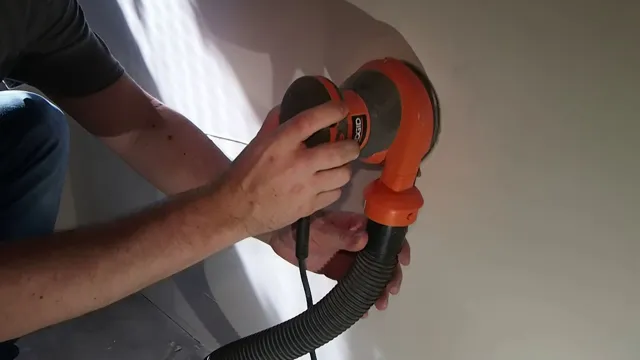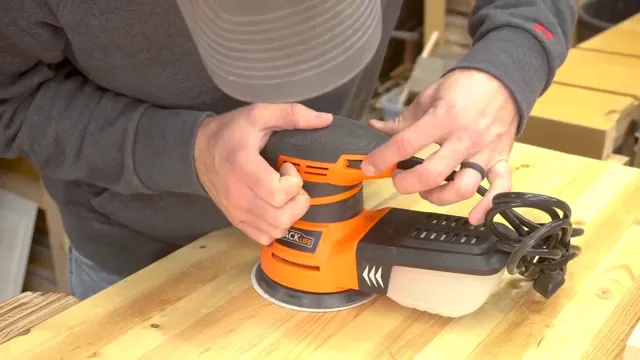Can I Use an Orbital Sander for Drywall? Tips, Tricks, and Safety Measures.

Sanding drywall can be a daunting task, especially if you don’t have the right tools. But using an orbital sander can make the process much easier and faster. If you’re new to using an orbital sander for drywall, you might have many questions such as what type of sander to choose, what grit of sandpaper to use, and how to properly sand without damaging the drywall.
Don’t worry; we’ve got you covered. In this blog, we’ll go through everything you need to know about using an orbital sander for drywall, including helpful tips and tricks, so you can get the job done like a pro. So, let’s get started!
Introduction
If you’re wondering whether you can use an orbital sander for drywall, the short answer is yes. However, while an orbital sander can be used for a smooth finish, it’s not the best tool for the job. Orbital sanders are typically designed for woodworking tasks, so using one on drywall could result in uneven sanding, scratches or damage to the surface.
A better option would be to use a dedicated drywall sander, which has a longer handle for reaching ceiling and wall areas without the need for a ladder, and is specifically designed to handle drywall surfaces. Additionally, drywall sanders come with a vacuum system that effectively collects dust and debris, making the cleanup process much easier. So, while an orbital sander can be used for drywall, it’s not the ideal or most efficient tool for the job.
What is an orbital sander?
An orbital sander is a power tool that is commonly used in woodworking and DIY projects. It is a type of sander that moves in a circular or elliptical pattern, hence the name “orbital”. The tool has a circular sanding pad that spins at high speeds, allowing it to quickly and efficiently remove material from various surfaces.
Orbits are measured in diameter, and higher orbits of 5mm or more are generally preferred for larger surfaces, while smaller sizes are best for delicate tasks. An orbital sander is an essential tool for sanding and preparing surfaces for painting, staining, or further finishing. Its versatility and ease of use make it a popular choice for both professional woodworkers and DIY enthusiasts alike.

What is drywall?
Drywall, also known as gypsum board or plasterboard, is a material used in construction and renovation projects to create walls and ceilings. It is composed of a core of gypsum, a mineral made up of calcium sulfate, sandwiched between two sheets of paper. This material is widely popular due to its ease of installation, durability, and versatility.
Drywall comes in various sizes, thicknesses, and types, including moisture-resistant and fire-resistant options. It is also a cost-effective alternative to traditional plaster walls, making it a top choice for homeowners and contractors alike. Whether you are building a new home or renovating an existing one, drywall is an essential component that helps create the space you envision.
Can You Use an Orbital Sander for Drywall?
If you’re a DIY enthusiast looking to tackle a drywall project, you might be wondering if you can use an orbital sander for the job. The short answer is yes, you can. An orbital sander can be a convenient and efficient tool for smoothing out drywall after it’s been hung and taped.
However, there are a few things you should keep in mind before using an orbital sander for drywall. First and foremost, make sure you’re using the right sandpaper. Drywall sandpaper (also called screen or sanding mesh) is specially designed to resist clogging and tearing, and is available in grits ranging from coarse to fine.
Additionally, be prepared for the dust created by sanding drywall to be intense and potentially hazardous to your health. Be sure to wear a dust mask, safety glasses, and work in a well-ventilated area. With the right safety precautions in place, an orbital sander can be a handy tool to help you achieve a smooth and professional-looking finish on your drywall project.
Advantages of using an orbital sander for drywall
Using an orbital sander for drywall has its advantages. One of the biggest benefits is that it provides a smooth finish that’s free from any scratches or swirls. This is because an orbital sander moves in small circular motions, which ensures that sanding is evenly distributed and prevents any unwanted patterns on the surface.
Additionally, an orbital sander can easily reach corners and tight spaces that other sanders may struggle with. It also doesn’t require too much force, making it more user-friendly and fatigue-resistant. However, it’s important to note that only a specific type of orbital sander, known as a random orbital sander, can be used on drywall.
This sander has a round pad that eliminates the risk of leaving circular marks on the surface, making it ideal for drywall sanding. Overall, using an orbital sander for drywall provides a smooth and professional-looking finish, making it a great option for beginners and professionals alike.
Disadvantages of using an orbital sander for drywall
While an orbital sander might be a useful tool for various sanding tasks, it might not be the best choice when it comes to drywall. One of the most significant disadvantages of using an orbital sander for drywall is that it can create swirl marks on the surface. These marks can be challenging to remove, and they can remain visible even after the painting is complete.
Additionally, using an orbital sander on drywall can also create a lot of dust, which can be harmful if inhaled or ingested. It can also create a mess, making it challenging to keep the worksite clean. Therefore, it’s advisable to use a sanding sponge, a sanding pole, or a drywall sander instead.
These tools are designed specifically for drywall sanding and can help minimize dust and prevent swirl marks on the surface. Overall, using an orbital sander for drywall may not be the best option, and it’s essential to consider the potential disadvantages before making a decision.
Safety precautions for using an orbital sander on drywall
Orbital sander, Drywall, Safety Precautions If you are planning to renovate your home and want to smooth out the rough patches on your drywall, using an orbital sander can be a great idea. However, it is important to take some necessary safety precautions to avoid any accidents or damage to your walls. Firstly, always wear protective gear, including gloves and safety glasses, to prevent flying debris from causing any harm to your eyes or skin.
Secondly, use a vacuum cleaner or dust collector to avoid inhaling excessive dust and to keep your workspace clean. It is also important to use the correct sandpaper grit for the job, as using a too coarse grit can damage the drywall surface and a too fine grit may not produce the desired smoothness. Lastly, avoid applying too much pressure on the sander, as it can cause damage to the drywall.
Using an orbital sander for drywall can produce great results, but it is important to follow the necessary safety precautions to ensure both a smooth finish and your safety.
Alternatives to Using Orbital Sanders on Drywall
Many people wonder if using an orbital sander is a good idea when it comes to drywall. While some DIY enthusiasts might recommend using an orbital sander, professionals in the field advise against it. This is because the fast spinning motion of an orbital sander can cause damage to the drywall.
Instead, you can try using a sanding sponge or sandpaper, which will offer you more control over the amount of pressure you apply to the surface. Another option is to try a drywall sanding pole. These tools are specifically designed for drywall sanding and provide better reach and control for sanding larger areas.
So, while an orbital sander might seem like a quick fix, it can end up causing more damage. Stick to a sanding sponge, sandpaper, or a specialized drywall sanding tool for the best results.
Hand sanding
Hand Sanding While orbital sanders are a popular choice for smoothing out drywall surfaces, there are alternative methods that can be just as effective and save you time and money in the long run. Hand sanding, in particular, can be a great option for those who don’t mind putting in a little elbow grease. With the right tools, such as a sanding block and sandpaper, you can achieve a smooth and even finish on your walls.
Plus, hand sanding allows for greater precision and control, making it ideal for tackling smaller areas or hard-to-reach corners. While it may take a bit more patience and effort than using an orbital sander, hand sanding is a viable option for those looking to save on equipment costs and get a more personalized touch.
Pole sanding
Pole sanding is an effective alternative to using orbital sanders on drywall. It involves attaching a sanding head to an extendable pole, allowing you to reach high and difficult-to-reach spots with ease. Pole sanding results in a smooth and even finish, and eliminates the need for a ladder or scaffolding.
It is also less dusty than traditional sanding methods, making it a popular choice for those with allergies or respiratory issues. However, it requires more physical effort than using an orbital sander, and may take longer to cover a large area. Overall, pole sanding is a great option for those looking for a more efficient and safe way to sand their drywalls.
Conclusion
In conclusion, using an orbital sander for drywall might seem like a good idea at first, but it’s ultimately about as useful as trying to hammer a nail with a spatula. Sure, it might make some noise and vibration, but it’s likely to be more frustrating than effective. When it comes to drywall, it’s best to stick with the recommended tools and techniques for a smooth and successful finish.
“
FAQs
Is it okay to use an orbital sander for drywall?
Yes, an orbital sander can be used for drywall sanding, but it’s important to use the right sandpaper grit and technique to achieve a smooth finish.
What is the recommended sandpaper grit for drywall sanding with an orbital sander?
For initial sanding of drywall seams and joints with an orbital sander, it’s recommended to use 120-grit sandpaper. For final sanding, use a 220-grit sandpaper.
Can I use a random orbit sander for drywall sanding?
Yes, you can use a random orbit sander for drywall sanding, but it’s important to use the right sandpaper grit and technique to avoid damaging the drywall surface.
Is it better to use a hand-held sander or pole sander for drywall sanding?
It depends on the size and height of the drywall area to be sanded. For smaller areas, a hand-held sander is recommended, while a pole sander is better for larger wall or ceiling areas.
How do I avoid over-sanding or damaging the drywall surface when using an orbital sander?
Use light pressure and smooth circular motions when sanding with an orbital sander, and be careful not to stay in one spot for too long. Check the sandpaper regularly and change it when it becomes dull or clogged.
Should I use a vacuum or dust collector with my orbital sander when sanding drywall?
Yes, it’s highly recommended to use a vacuum or dust collector with an orbital sander for drywall sanding to minimize dust accumulation and improve air quality.
What are some common mistakes to avoid when using an orbital sander for drywall sanding?
Some mistakes to avoid include using too much pressure, sanding too aggressively, not using the right sandpaper grit, and not wearing proper safety gear like a mask and eyewear.







